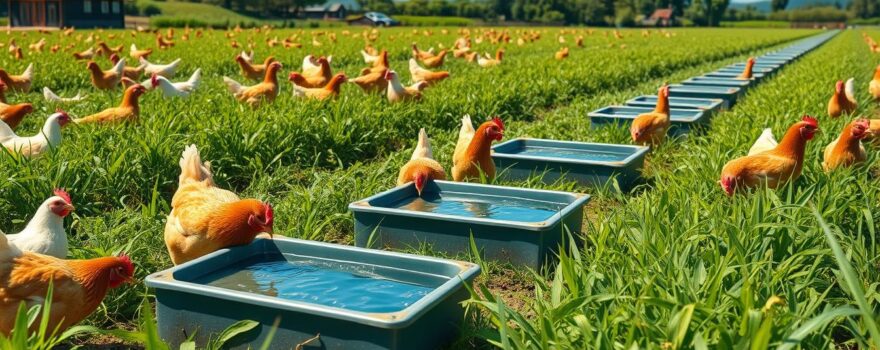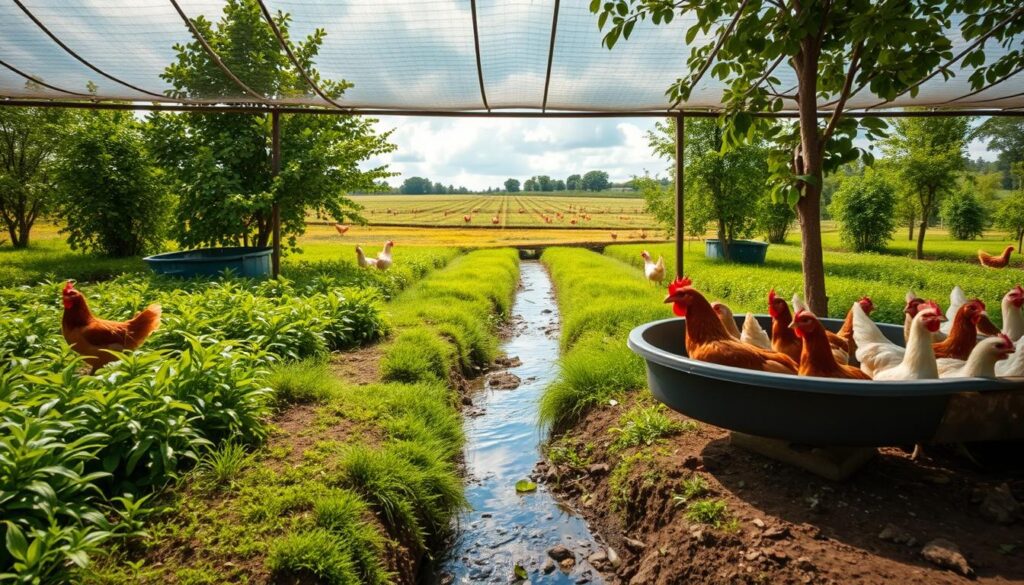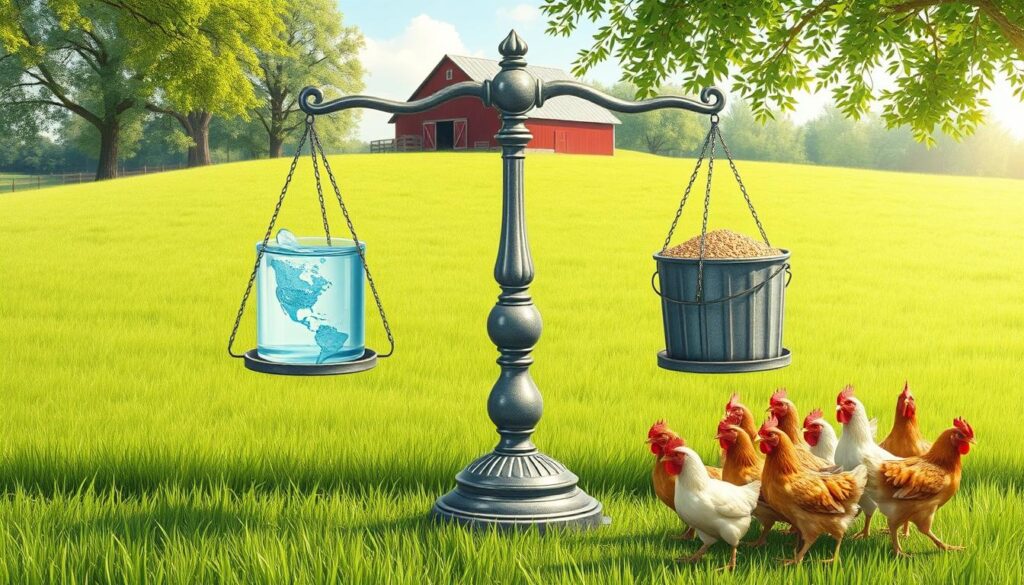
Water is essential for all living things, and using it wisely is key to sustainable farming. In the poultry world, how much water broiler chickens drink affects their health, work, and the environment. As the poultry industry grows, so does its focus on using water better and caring for the planet.
Broiler chickens, the main meat source, need a lot of water. Aviagen says 70-80% of what they drink ends up as waste. This shows how important water is in raising broilers and why we need to manage it well.
The poultry industry has really cut down on its environmental harm. Today, it takes less land, water, and resources to raise the same amount of chicken as in 1965. Greenhouse gas emissions have dropped by 36%, and land and water use have fallen by 72% and 58%, respectively. These numbers show the industry’s dedication to being green and its potential to do even better with water.
Key Takeaways
- Water is a critical nutrient for broiler chickens, with around 70-80% of the water consumed being excreted or expelled as moisture.
- Responsible water usage is crucial for the sustainability of broiler chicken farming, as the industry aims to reduce its environmental footprint.
- The poultry industry has made significant strides in improving resource efficiency, including a 50% decrease in environmental impact, 75% reduction in resources required, and 58% decrease in water consumption.
- Sustainable water management practices are essential for maintaining broiler health, productivity, and overall industry sustainability.
- Monitoring and optimizing water intake and usage can help identify and address any performance or health issues in broiler chicken production.
The Importance of Sustainable Water Usage in Broiler Production
Water is key for broiler chickens, helping them stay healthy and productive. Making sure we use water wisely in broiler production is vital. It’s good for the birds and helps the whole industry be more sustainable.
Water: A Key Nutrient for Broiler Health and Productivity
Broiler chickens need clean, fresh water to do well. Water helps them keep cool, digest food, and get nutrients. Good water management boosts their health and productivity.
Broilers drink a lot of water, about 1.6 to 2.0 times as much as food. They use more water as they grow, especially with changes in season or feed. Their water needs also depend on their health.
“Ensuring broilers optimise their water intake not only promotes the sustainability of broiler production through its influence on energy (ventilation) and water use, but also maximises broiler health, welfare, and production.”
By using water wisely in broiler production, we help the industry and the birds. This approach supports the industry’s goal of being responsible and eco-friendly.
Water Intake and Gut Health in Broilers
Keeping the right amount of water is key for broiler gut health. Changes in water intake can signal intestinal problems. Birds drink more when it’s hot to cool down, which can harm their gut.
Drinking too much water can mean the water has too many minerals, like sodium. This can make the gut wetter, leading to wet feces. This makes the litter moist, which is good for the Eimeria parasite and increases coccidiosis risk.
About 70-80% of the water a broiler drinks ends up as droppings or moisture. This moisture needs to be removed from the house. Birds spend about 6% of their time drinking and eating, with mash diets taking longer than pelleted ones.
Broilers make around 16 trips to the drinker each day. Each trip lasts about three visits. As they get older, they drink more water but for less time. They also make more trips to the drinker.
“Inadequate water supply can result in reduced feed intake and health issues.”
It’s important to keep the water-to-feed ratio right for broiler health. This ratio changes as broilers get older. It goes from 1.931:1 at 11 days to 1.715:1 at 46 days. The ratio also changes with the season.
The Impact of Water Usage on Broiler Chicken Farming Sustainability
Poultry is a big source of animal protein, but it uses a lot of water. Chicken uses 4,300 liters of water per kilogram, which is less than beef. But, the growth of chicken farming means water might not always be available.
This creates big challenges for chicken farming. Water stress affects many countries, making it hard to keep chickens hydrated. About one-third of the world’s water goes to farming, including chicken.
Not having enough water hurts chicken health. It can make chickens eat more and grow slower. Some chickens are better at dealing with less water than others.
| Livestock Animal | Water Footprint per kg of Meat (Liters) |
|---|---|
| Beef Cattle | 15,400 |
| Sheep | 10,400 |
| Pig | 6,000 |
| Goat | 5,500 |
| Chicken | 4,300 |
Climate change also affects chicken farming. It’s making the Earth warmer and changing weather patterns. This can hurt chicken health and farming.
To solve these problems, we need to manage water better. We should use less water and find new sources. This will help chicken farming stay sustainable for the future.

Diurnal Patterns of Water Intake in Broilers
Broiler chickens have a clear pattern in how they drink water. Their water intake matches their eating habits. Most of their drinking happens when the lights are on in their home.
They drink the most right after the lights come on. This is because they want to refill their water quickly.
Key Times for Broiler Water Consumption
Knowing when broilers drink is key to managing their water. They drink most during certain times:
- Right after the morning lights come on
- In the middle of the day when they’re most active
- Early in the evening before the lights go off
By making water available during these times, farmers can help their birds stay healthy and grow well.
The way broilers drink water is important for farming them sustainably. Knowing when they drink helps farmers use water wisely. This makes broiler farming more sustainable.
Drinking Behavior and Water Intake Management
Managing water intake is key for broilers to perform well and sustainably. Broilers drink like they eat, with many “drinking bouts” a day. Knowing this helps producers keep their flocks hydrated.
Research shows that drinker type affects broiler drinking habits. Birds with bell drinkers drink less often but more water each time. This shows choosing the right drinker is vital for water efficiency.
Temperature also affects how much water broilers drink. In hot weather, they drink more to stay cool. It’s important to adjust water access during heat waves to keep them healthy.
“Water access is crucial for broiler development, especially under high environmental temperatures. Factors such as diet composition, water quality, and environmental temperature can all influence broiler water intake behavior.”
Understanding broiler drinking habits helps producers make their farms more sustainable. They can choose the best drinkers, keep water flowing right, and watch water use closely. This ensures the birds stay hydrated.
Effective water management is essential for sustainable broiler farming. It improves bird health, performance, and the farm’s environmental impact.
Water-to-Feed Ratio: A Key Indicator of Broiler Performance
The water-to-feed ratio is a key metric for poultry producers. It shows how well broiler chickens are doing. If there’s not enough water, chickens might eat less, which can harm their growth and health.
Research shows that a broiler chicken drinks about 18 pounds of water in its lifetime. This is more than the 10 pounds of feed it eats. Keeping the right water-to-feed ratio is crucial for their health.
By watching the water-to-feed ratio, producers can learn a lot about their chickens. Changes in water intake often mean changes in feed intake too. This is why it’s important to make sure chickens have enough water and a good way to get it.
| Parameter | Value |
|---|---|
| Lifetime Water Consumption | 18 pounds (8.2 kg) |
| Lifetime Feed Consumption | 10 pounds |
| Daily Water Consumption (60-day old bird) | 12 ounces |
| Correlation between Feed and Water Intake | 98% |
By keeping an eye on the water-to-feed ratio, producers can spot problems early. This helps them make changes to keep their chickens healthy and growing well. It also helps them use water wisely in their operations.

Climate Change and Water Scarcity Challenges
Climate change is a big threat to freshwater around the world. It causes rising temperatures, changes in rain, and more extreme weather. This leads to a growing water shortage crisis. By 2025, two-thirds of the world’s people might not have enough water.
Factors Contributing to Freshwater Scarcity
Several things have made freshwater very scarce. These include:
- Rapid growth of the global population
- Urbanization and increasing water demands in cities
- Water pollution from industrial, agricultural, and domestic sources
- Inefficient management and poor governance of water resources
These issues, along with climate change, have put a lot of pressure on freshwater. The broiler chicken industry, which uses a lot of water, must find ways to be more sustainable.
| Region | Relative Change in Chicken Meat Production (2000-2021) |
|---|---|
| Asia | 132% |
| Europe | 109% |
| North America | 55% |
| South America | 140% |
| Oceania | 113% |
| Africa | 161% |
The broiler industry needs to use water wisely and reduce greenhouse gas emissions. It must adopt sustainable practices to face climate change and water scarcity challenges.
“By 2025, two-thirds of the world’s population may face water shortages.”
Effects of Limited Water Access on Broiler Performance
Access to clean, fresh water is key for broiler chicken farming. But, not having enough water can harm their growth, how well they use feed, and meat quality. It’s vital to know these effects for sustainable farming, especially in dry areas.
Studies show different chicken breeds react differently to less water. For example, slow-growing breeds like Naked Neck (NNK) and Ovambo (OVB) adapt better than fast-growing commercial ones. Ovambo chickens did better in body weight, growth, and water use compared to Naked Neck chickens under water limits.
As water gets scarcer, many important factors get worse. Body weight, growth, feed, and water intake all go down. Feed conversion ratio (FCR) goes up. But, Naked Neck chickens do better with FCR when water is really limited.
Water limits also change how chickens look on the inside. Birds with less water have more dressed weight but smaller hearts. This shows they might be saving water in their bodies.
These results highlight the need to pick chicken breeds that can handle drought. We also need good water management to keep broiler farming going, especially in dry places.
“Understanding the effects of restricted water intake on chicken strains is crucial for identifying drought-tolerant strains for food security in drought-prone areas.”
Sustainable Solutions for Water Conservation in Broiler Production
The poultry industry faces a big challenge with water scarcity. But, there are new ways to solve this problem. One idea is to choose chicken breeds that use less water.
These breeds are more resilient and can handle less water. This could be a big help for broiler farms with limited water.
It’s also important to use water-saving methods. For example, collecting rainwater and using drip irrigation can cut down on water use. Adding automated feeders and waterers helps too. They make sure the chickens always have water and reduce waste.
Rules and organic certifications are key too. Following these standards helps farmers show they care about the environment. It also attracts customers who want to buy poultry that’s good for the planet.
Building strong brands and using digital marketing can help spread the word. This way, more people can learn about and support sustainable broiler production.